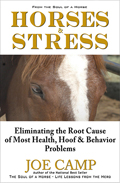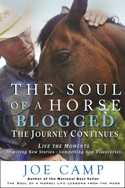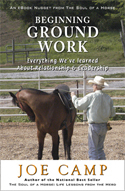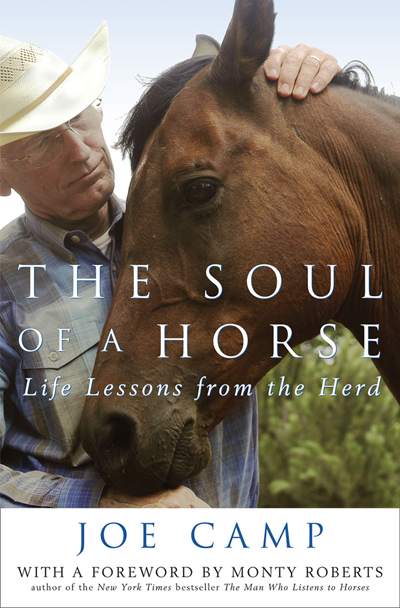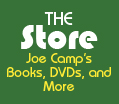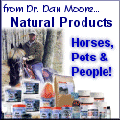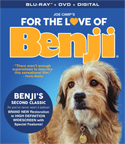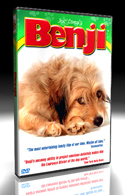Early on in this amazing journey with horses we began realize how much better everything became when we began to look at things from the horse’s end of the lead rope instead of our own. When we began to ask ourselves What’s in it for the horse? Why should he want to be with us? At first these questions pretty much related to relationship and training, but very quickly they spread into every aspect of the care and keeping of these magnificent creatures. Lifestyle, Diet, Feet, the concept of Liberty, as well as Relationship. Only by understanding all of these from the horse’s perspective could we begin to approach that illusory state of mind referred to as Horsemanship. We were discovering that horsemanship could never just be about how well we ride, or how many trophies we win, or how fast our horse runs, or how high he or she jumps.
In those early days we spent an incredible amount of time out in the pasture. In the round pen. Feeding. And just hanging out. Observing. Listening. Learning. It’s amazing what you’ll hear when you listen. Here’s how my Cash put it in the Introduction to The Soul of a Horse – Life Lessons from the Herd:
My name is Cash. I am horse.
I have been on this planet for some fifty-two million years. Well, not me personally. My ancestors. It all began in North America, somewhere near what is now called Utah. We hung out and evolved for most of that time, then we began to migrate to South America, and across the Bering Straits Bridge to Asia, Europe, and Africa. And, eventually, some ten thousand years after we left, we were brought back home by the Spanish conquistadors.
We’ve been through it all. Ice Ages. Volcanic periods. Meteor strikes. Dinosaurs. You name it. And we survived.
We’ve only been carrying man around for, oh, the last three to four thousand years. We’ve helped him farm, hunt, travel, and fight his enemies. We were helping man shape world history, winning wars for him, as far back as 1345 BC. We protected kings’ dominions in medieval times, carried knights into the Crusades, fought on European battlefields all the way into the early 1900s, and we helped conquer and settle the American West.
Throughout these millions of years, many of us have remained wild and free. Even today, our herds roam free in Australia, New Zealand, Mongolia, France, Africa, the Greek Island of Cephalonia, Abaco in the Bahamas, Sable Island in Nova Scotia, the Canadian West, several states of the American West, Virginia, and North Carolina.
And until recently, we’ve done it all pretty much naked and in good relationship with man. But over the past several hundred years things began to change. Changes that are actually inexplicable, given that our genetics and history are widely known. You see, we are not cave dwellers. We don’t like dark cozy rooms, clothing, iron shoes, heat, air conditioning, and we’re not built to stand around all day in one place eating from a tub virtually withers high.
Humans seem to like all that. And because they do they presume we should like it too. But we’re movers and shakers. In the wild we’ll move ten to twenty miles a day, keeping our hooves flexing and circulating blood, feeding our tiny little stomachs a little at a time, and keeping our own thermoregulatory systems in good working order.
Think about it. Our survival through all those millions of years has built a pretty darned determined genetic system. And an excellent formula for survival. We are what you humans call prey animals, flight animals. We are not predators, like you. We have survived because we freak out at every little thing, race off and don’t look back. We are also herd animals. Not just because it’s fun to be around our pals, but because there is safety in numbers. And being a prey animal, safety is just about the most important thing to us. But our idea of safety is not the same as yours. Our genetic history does not understand being all alone in a twelve-by-twelve stall. Even if it’s lined in velvet, in a heated barn, it’s away from the herd and by no stretch of the emotion or imagination is that a safe haven! Stress is all we get from such an experience.
Stress. Big time!
Have you ever seen one of us, locked in a stall, pacing… pawing… swaying… gnawing? That horse is saying Let me outta here!! I need to move! I need to circulate some blood!
And about these metal shoes nailed to our feet. Have you ever seen a horse in the wild with metal shoes? I don’t think so. There is nothing more important to a prey animal than good feet. And ours have helped us survive for millions and millions of years. Rock crushing hard and healthy.
But once upon a time, back in medieval days, some king decided he would be safer if he built his castle and fortress up on top of a high hill or mountain top. He still needed us to fight his wars, and move things and people around, but up there on top of the hill, there were no pastures like down in the valley. So he put us in small holding pens where we had to stand around all day, in our own pee and poop, and guess what happened to our feet. It wasn’t the moisture so much as the ammonia. Ate our feet up! So when they’d take us out onto those hard stone roads… well, you can imagine.
The king’s blacksmith came up with the idea of nailing metal shoes on to our hooves, to keep them from disintegrating when pounding the stony roads. There was a much simpler, healthier solution, but, unfortunately, it escaped the king and his blacksmith. Then, all the king’s men and all the king’s horses went down the hill… and all the king’s peasants, living in the valley, where their horses were out in the field, happy as clams with strong and healthy hooves, saw these shiny, newfangled pieces of metal on the king’s horses, and what did they say? Surely the king knows best! We must have some of those shiny metal things for our own horses!
And so it went for generations.
You humans are funny that way. And you say we follow the herd.
Joe and I have had long discussions about all this and he seems to be getting it. So I can shamelessly recommend what follows. Joe has spent much of his life trying to lure you into the heart and soul of a dog and now he’s trying to lure you into the heart and soul of a horse. For it is there that he first began to comprehend the vast differences between us and you, and the kind of thinking that can bridge that gap and bind us together in relationship. My herd mates and I have taught him well. And, believe it or not, the philosophy behind everything he has learned doesn’t just apply to horses, but to how you humans approach life as well. So whether or not you have a relationship with a horse, I think you’ll find this journey of discovery fascinating.
I did.
And I already knew the story.
The comic strip character Pogo once said, “We have found the enemy and it is us.” The problem with most issues concerning horses, we discovered, is not the horse, it’s us. But I try to always remember that information is king. All across this site we have links (Resource Lists) to all sorts of books and resources that will provide you with more medical, technical, compassionate, and emotional material than you will ever need to prove to yourself that:
1. Horses have one of the best thermo-regulatory systems in the world. In virtually any climate and any geographical region their systems have more than what’s needed to maintain their core body temperature at 38 degrees Celsius. “Blankets are a thermoregulatory nightmare for horses,” says Dr. Hiltrud Strasser. Blankets prevent a horse from properly growing a winter coat, and when stripped of his blanket to ride in winter, he will not be prepared to protect himself against the low temperatures. Again, it’s an issue fostered by humans. Winter is cold for us and we bundle up, so we think it must be logical that bundling up should be good for horses as well, when, in reality it’s the worst thing we can do. Same is true of heated and cooled barns and stables. Another issue (very logical actually) with blankets is that they only cover part of the body, and, within the horses system, in order to warm any part of the body, all the body must be warmed, thus some part is destined to be too hot or too cold, robbing the horse of its natural, complex, and highly efficient thermoregulatory system. See out Blog Post: An Amazing Artcle on WHy Horses Should Not Be Blanketed in Winter
2., The blood vessels in the lower leg are very small in diameter when the horse is at rest, which is when leg wraps are put on, snugly, tightly. Then the horse begins to move, usually a lot, and the vessels need to increase their diameter to sufficiently circulate enough blood in the lower leg and hoof and return it to the heart, but this increased circulation is inhibited by the constricting wraps. There are also tendon issues. The book A Lifetime of Soundness, has several pages on this which you should read. Also, I have heard from many vets who have said the wraps do not give any real protection for the leg, except, perhaps, preventing a nick or two if one hoof hits another leg. So if you must use them, keep them loose so the vessels in the leg can expand and contract. Again, information is king.
3. Horses in the wild did just fine without metal shoes nailed on their feet for something like 50 million years before humans got hold of them. As a prey animal, a flight animal, they would’ve been extinct eons ago if they didn’t know how to grow rock-solid feet that could run from predators and travel 18-20 miles a day in search of food and water. Still, more often than not, when I ask folks why they have shoes on their horses, the answers come back, “Well, it’s always been done that way.” When I press, it goes something like this:
“I guess it’s because the hooves are not strong enough without them.”
“Why,” I ask.
“I don’t know,” they usually say.
“Don’t you think you should know?” I ask.
“Well,” they shrug, “everybody else has shoes. So it must be right.”
And the reality is: it isn’t.
Not even close to right. For more on this please read the section here on our website on Bare Feet.
4. Your horse should be turned out 24/7. No box stalls, however fancy and well equipped. You cannot imagine the stress this causes your horse, which in turn causes all sorts of medical and emotional problems. See the section on Lifestyle. And Take This Stress Test
So, Joe… are you saying that my horse needs thousands of acres to run around with other horses, and must travel ten to fifteen miles every day? Not at all. And it’s not as problematic as you might think. We had two turnouts in California, each not much bigger than a barn. Steep and rocky. We mucked the turnouts twice a day and the hay is scattered, at ground level (which is how a horse was meant to eat, neck stretched to the ground) in at least twenty separate small piles around the turnout so the horses are in movement throughout the eating periods, moving from one pile to another. With all that movement (and blood circulation increase) their previously shod feet became sound and strong so quickly it was astounding. We had two horses in one turnout and three in the other, so the five were constantly together. Then all all of them moved to a similar pasture, approximately an acre and a half, very steep and rocky, again, with their hay being scattered all around the pasture (see the video Our Paddocks Paradise).
5. Ride bareback, at least some of the time.
Some of the most fun we and our horses have together is riding bareback with nothing more than a halter and looped lead rope. In less than a year, we have brought all of our horses up to be so responsive, trusting and caring about our desires, that truly they perform just as well, actually better, in a halter as they did in a bridle. And they love bareback because they don’t have the weight of the saddle and they can feel our bodies, and we can feel theirs. Whether you’re trying to have more body/leg contact with your horse, or improve the balance point of your seat, or just have a quick ride without the hassle of tacking up, bareback is terrific, for both of you. And learn to train your horse so that your reins are always loose, preferably bitless, not tugging on your horses mouth. Teach your horse to do your bidding because it’s his choice, not because you are forcing him by tugging on a bit. Watch Stacy Westfall’s video and get inspired as she wins a reining competition with no bridle or saddle at all!
Six months ago, Kathleen would not even think of getting on a horse bareback, and now she rides more bareback than with a saddle. Feeling your horse and how she moves and she reacts to your various body positions and cues gives such a better understanding to what you need to do when in the saddle. Obviously, you should be careful, and go no faster than your seat is comfortable with, and if you haven’t done the Beginning Groundwork to insure that you and your horse have a trusting partnership, that needs to be done first. But when you’re ready, riding bareback can truly enhance your overall horsemanship. Again, once you’ve started, get a copy of Stacy Westfall’s DVD and learn how to do a complete reining demo with no bridle, no halter, and no saddle. Amazing!
6. Train through relationship first.
We began our journey gobbling up the terrific material of renowned trainers and clinicians like Monty Roberts, Charles Wilhelm, John Lyons, Stacy Westfall, Pat and Linda Parelli, Allen Pogue, and natural hoof care specialists like Pete Ramey, Eddie Drabek, and Jaime Jackson. Gobbling up, in effect, hundreds of years of experience in a very short time. And sorting through their methods, applying the best of what works for us. Every day I’m amazed at how far one horse or the other has come, how these methods work; and all it takes is some knowledge, focus, and time, and beginning with relationship first is a must. Then Leadership through ground work. Then liberty. And suddenly your life with your horse has changed for the better, better, better! It’s really that simple. Stacy Westfall recently said that the best thing she has ever done for her training is to do no training until the relationship is right.
During our first year on this journey, I trailered one of our horses across town, a horse who came to us five months before, green broke with very little mileage and not much ground work. But he learned to focus with a capital F. He caught his foot in the hay feeder in the trailer and, as I entered the trailer to unload him, he freaked out completely. Imagine being in a trailer with a horse used to four legs having only three. But instead of winding up in the hospital, I wound up with his leg out of the hay feeder, with him focused on me, paying strict attention, even though his eyes were blazed and his nostrils flared. He listened, he backed, he yielded, and allowed me to walk calmly out of the the trailer first, with him following… calmly. The entire story is told in The Soul of a Horse. But leadership is all about ground work. This, with Join Up, or No Agenda Time, is the foundation we worked on with each of our horses.
We started on the ground, getting to know our horses and what makes them tick, and establishing a real relationship. Giving them the choice of whether they want to be with us or not. A horse is not a motorcycle but is a living, breathing, fearful flight animal who needs and wants a good leader and friend. We believe in beginning a horse so that he will learn without fear, be safe, be attentive and desirous to please, and will be well prepared for a long and happy relationship. His choice. Of his own free will. See Why Relationship First Works. That’s the important part. That’s what changes everything. Our horses range in age from baby to twenty-seven, but they all began with us (or are beginning with us) the same way, and have been brought along the same way. It’s truly amazing to watch an older, well-schooled horse re-learn everything and become a willing and desirous partner and friend.
Not long ago we were scared out of our minds by these 1000-pound animals. We aren’t multiple-time world champions or thirty year veterans, but Kathleen and I have had the benefit of more amazing experts than you’ve ever found in one place before. Our goal is to inspire you to learn, and apply, and trust yourself to figure things out instead of clinging to “somebody else’s “paint by numbers” horsemanship. And to discover the pure joy of seeing that something so simple actually works.
Read More About Horses, Benji, Goals in Life: joecamp.info
—–
Buy ’em – Try ’em
Save 10% by clicking this link
and using the coupon code JOECAMP10 at checkout
Read More
Download Flyer
Send a copy of your Omega Nibblers email purchase confirmation to
nancy@thesoulofahorse.com
and receive a free PDF copy of Training with Treats!
The story of our journey with horses (to date) is told in the two books that follow: the national best seller The Soul of a Horse – Life Lessons from the Herd and its sequel Born Wild – The Soul of a Horse.
And what a story it is as two novices without a clue stumble and bumble their way through the learning process so that hopefully you won’t have to. If you haven’t read both of these books already please do because with that reading, I believe, will come not just the knowledge of discovery but the passion and the excitement to cause you to commit to your journey with horses, to do for the horse without waiver so that your relationship and experience will be with loving, happy and healthy horses who are willing partners and who never stop trying for you. Horses like ours.
Read the National Best Seller that started it all.
Now in its 17th Printing.
National Best Seller
#1 Amazon Best Seller
#1 Amazon “Hot New Releases”
At Bookstores Everywhere
Amazon & Kindle
Barnes & Noble
Order Personally Inscribed Copies of The Soul of a Horse
Order Both The Soul of a Horse & Born Wild – Save 20%
Both Personally Inscribed
Please list the names for each inscription in the “instructions to Seller” field as you check out!
Read More About The Soul of a Horse
Watch The Soul of a Horse Trailer
The highly acclaimed best selling sequel to
The Soul of a Horse – Life Lessons from the Herd
#1 Amazon Best Seller
#1 Amazon “Hot New Releases”
Amazon & Kindle
B&N
Order Personally Inscribed Copies of Born Wild
Order Both The Soul of a Horse & Born Wild – Save 20%
Both Personally Inscribed
Please list the names for each inscription in the “instructions to Seller” field as you check out!
Read More About Born Wild
Read More About The Soul of a Horse
Watch The Soul of a Horse Trailer
Watch the Born Wild Trailer
“Joe Camp is a master storyteller.” – The New York Times
“One cannot help but be touched by Camp’s love and sympathy for animals and by his eloquence on the subject.” – Michael Korda, The Washington Post
“Joe Camp is a natural when it comes to understanding how animals tick and a genius at telling us their story. His books are must-reads for those who love animals of any species.” – Monty Roberts – Author of New York Timers Best-seller The Man Who Listens to Horses
“Camp’s tightly-written, simply-designed and powerfully drawn chapters often read like short stories that flow from the heart.” Jack L. Kennedy – The Joplin Independent
“Joe Camp is a gifted storyteller and the results are magical. Joe entertains, educates and empowers, baring his own soul while articulating keystone principles of a modern revolution in horsemanship.” – Rick Lamb – TV/Radio host – The Horse Show
Watch The Soul of a Horse Book Trailer
Read More About Horses, Benji, Goals in Life: joecamp.info
Go to TheSoulOfaHorse.com Homepage



